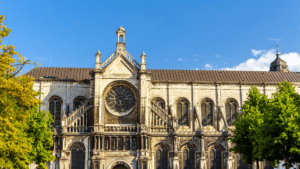Brussels is a city of contrast, with many districts that each have their own personality. For newcomers to Brussels, it can be difficult to figure out which neighborhoods they want to live in.
Whether you are planning a short city trip, a business trip or plan to live as an expat in Brussels, here is an overview of the city’s best neighborhoods.
Sainte-Catherine : a feast for the eyes and the stomach
The Sainte-Catherine area is one of the most beautiful neighbourhoods in Brussels. Partying is on the menu, as in many of the city centre’s surrounding areas, but it’s the restaurants that really make tourists’ and locals’ heads spin.
Sainte-Catherine church : one of brussels fairest jewels
The lighthouse of this district is the Sainte-Catherine church, designed in the 19th century by legendary architect Joseph Poelaert. This landmark of the Brussels centre’s architecture shines its light of beauty on the lively squares and typical streets surrounding it.
Delights from the sea, and much more
Located in the historical centre of Brussels, the streets of the Sainte-Catherine neighbourhood bear the names of former docks. Although the canal doesn’t water the basins anymore, fish still haunt many aspects of local life, especially the many mouth-watering restaurants’ menus.
Some of the basins have become cobblestone squares hosting cultural events and markets, while others still offer locals and tourists the opportunity to enjoy the view while casually cooling their feet in shallow pools during hot summer days.
A dry haven full of life
The area’s houses and buildings have remained faithful to the typical Brabant architecture, serving as the perfect decor for an afternoon special beer on one of the countless tavern terraces where students, locals, tourists and fashionistas all mingle effortlessly to enjoy the simple pleasures of life, sometimes until hours that would shame the most experienced nightlife enthusiasts.
A treat for every possible taste
Are you looking for a treat in Brussels ? Be it concert venues, theatres, clubs, restaurants, bars, specialised boutiques or street vendors chanting the freshness of their seafood and other Belgian delicacies, anyone is certain to find the very pleasure they just cannot resist. And the breathtaking winter market never fails to leave newcomers in awe when days get short, erasing the melancholy of Belgium’s cold long nights.
Dansaert : a bustling fashion district
Connecting the historic centre of Brussels to its canal, this neighbourhood paints a poetic allegory of the city’s recent artistic bloom rooted in cultural legacy. And just like Game of Thrones’ Jon Snow, it wears its bastard-like armor and waves it like the banner of its unique cultural richness.
From Brussels history to modernity
Located around the now covered river Zenne, craftsmen who needed its waters populated the area before the arrival of modern industries with similar needs. Brewers, papermakers and printers left their mark on this part of town where lofts have taken the place of factory floors, harmoniously embellished by the centuries-old cobblestone streets’ gorgeous architecture.
Industrial streets gone back to craftsmanship
In the early ’90s, designers and creators with dreamy eyes and empty pockets settled the Dansaert area, which offered cheap rents and perfect location to those who wanted to make it in Brussels. They now strive in this neighbourhood, easily competing with Antwerp’s fashion scene as the gravitational epicentre of pretty things and oddities. Nothing surprises locals anymore as creatives of all kinds flock to the area, safe in the knowledge that originality is worshiped in all its forms around here.
Drinks and food: choosing is the toughest part
Hip bars seem to pop off the ground, as creatives are a thirsty kin. Business incubators attract all types of restaurants and taverns eager to offer menus as original as the local fauna, always on the look for new trends to wear AND eat. The Brussels Beer Project, an urban brewery dedicated to propel the Belgian beer culture in the 21st century, is established on Dansaert Street and perfectly embodies this marriage of Old and New Brussels, blending the best of both worlds.
The zinneke way: how Brussels’ diversity made it thrive
Zinneke (derived from the river Zenne’s name) is a Brussels word referring to bastard dogs of mixed races. It is often used by Brussels inhabitants to define themselves, as they increasingly rarely have ‘purely’ Brussels roots. This mix of cultures and origins is often seen as Brussels’ strength and pride, bastard dogs being smarter than interbred pedigree races with genetic pools too small to be healthy. Add a bit of typical, local self-derision to it, and you obtain a statue of a zinneke dog urinating on the sidewalk of one of Dansaert’s area landmarks.
The Sablon : a treasure-trove of antiques, restaurants and chocolate
In the middle of this chic neighbourhood located at the fringes of Brussels’ historical centre, Our Blessed Lady of the Sablon Church is flanked by two of the city’s most typical locations: the Grand Sablon and the Petit Sablon.
The latter is a 19th century park hosting 48 statues representing historical professions, while the former attracts locals and tourists alike, hunting for treasures hidden in the alleys of the Sablon Antiques and Books Market on a weekly basis.
Treasures and pleasures
Antique stores, restaurants, chocolatiers, trendy boutiques and hype bars encircle the Grand Sablon square, but the narrow streets surrounding the area also offer marvels to those who wander the mysterious – yet generous – paved alleys where shops seem like trophies to visitors, aware that the best things in life not always await in plain sight.
A taste of everything
Due to its location and disposition, the Sablon area seduce many architecture enthusiasts who will stand in awe as they discover the Palais de Justice, the Place Royale and the Palais d’Egmont, among other landmarks. But chocolate and pastry lovers will not be disappointed either, as many chocolatiers and other deliciousness specialists ornate the floor level of beautiful façades giving the neighbourhood its marvellous aspect.
Where it all begins…
Faithful to this traditional facet of the quarter, two important events of Brussels’ calendar still start in the shadow of Our Blessed Lady of the Sablon Church: the Ommegang, a centuries-old re-enactment of Emperor Charles V’s entry in Brussels in 1549, and the Saint-Verhaeghen parade with students celebrating their hazing, an important part of the Université Libre de Bruxelles and Vrije Universiteit Brussel’s folklore.
The Canal : a bridge between the city’s past and its future
From the residential districts in the south to the haven in the north of the city, this waterway is also the ideal axis for developing public transport and soft mobility: crossing the city via the Canal represents an effective solution to traffic issues, whether by boat or bicycle on the quays. And ongoing efforts to ensure cleaner water have already led to an encouraging renaissance of biodiversity. All these sustainable development opportunities offer the entire Canal area a dynamic potential that both public authorities and the private sector have already begun exploiting.
A promising future
How times have changed since Jacques Brel sang of the canal as a symbol of grey sadness!
Denizens and authorities have been working hard to rehabilitate this special part of Brussels, crossing it south to north. More and more, this area is being seen in a more positive light, illustrating the diversity, history, and range of atmospheres that make up Brussels. And it’s also become a major environmental asset, as biodiversity has been making a comeback thanks to its waters the last few years… A link between the past and the future.
Like most major cities, Brussels sprouted from the banks of a river, the Senne. In the 16th century, the need for a stable and navigable waterway translated into the digging of a canal linking Brussels to the Escaut river, and thus the North Sea. In the 19th century, the canal was prolonged southward towards Charleroi and its coal mines. Both eras correspond to periods that saw Brussels flourish and prosper, thanks to the development of commerce and industry that the canal contributed to boost.
Between the centre and neighboring municipalities
Long considered a barrier, the Canal, as locals call it, is now turning into the bridge that reconciles the city centre with the rest of the Region. Since the industrial era, residents have always kept its neighbourhoods and businesses alive. However, this space has struggled to recover from its deindustrialisation phase. But it has been recovering thanks to the valorisation of its industrial heritage, which has been converted into museums, festival sites and other commercial and residential spaces.
A creative hotspot that makes the most of the city’s diversity
In recent years, creators, artists and other entrepreneurs have contributed to the revitalisation of the central part of the Canal, located between the city centre and the municipalities of Molenbeek and Anderlecht, from Tours & Taxis, which houses many shops as well as restaurants and a host of events throughout the year, to the abattoirs in Anderlecht where papilla celebrations are held, and to MIMA, the museum of modern art located at the former Belle-Vue brewery, rich in industrial and brewing history.
The port of Brussels, a haven for business
With the obvious advantage of direct waterway access, the vast available space managed by the Port of Brussels authorities offer logistic, productive and industrial businesses very interesting opportunities to settle in the Canal area. The central position of this long, city-traversing district makes its banks easily accessible to many residential and commercial neighbourhoods, while goods being produced on site are offered easy access to Belgium’s network of canals and ports. No other district in Brussels connects so rapidly to so many other areas inside as well as outside the city.
Saint-Jacques : festive venues and an open mind
Rarely asleep, the Saint-Jacques area embodies Brussels’ reputation of tolerance and openness… It is also one of the liveliest places in Brussels, where unique boutiques and festive venues will surprise and entertain visitors all day and all night long.
A pilgrimage through history
Tolerance and openness as the splendid Notre-Dame de Bon Secours church, formerly the Saint-Jacques Hospice where pilgrims used to rest for the night, sports its magnificent Spanish Baroque style in the middle of Brussels’ rainbow neighbourhood. The district illustrates perfectly the Belgian capital’s warmth – whatever the climate would have you believe – as well as what could very well be the city’s slogan: you’re all welcome just as you are.
Yes, the Manneken Pis is quite small. So what?
Ideally located between Brussels’ iconic Bourse building, the world’s most famous peeing boy, the Manneken Pis aka Petit Julien, and the statue of Belgium’s greatest poet and singer, Jacques Brel, the Saint-Jacques area is actually an open-air museum that will ravish the hearts of all cobblestone and 17th century architecture lovers. Flourishing since the 12th century, it was rebuilt almost entirely after the 1695 bombardment and many houses built in the years that followed still ornate Saint-Jacques’ streets.
Satiate all your appetites
Faithful to its middle ages status as a quarter dedicated to crafts, its boutiques paint a unique picture made of souvenir shops and pralines makers that delight the tourists, rare vinyl record specialists, book dealers, hipster clothing sellers, interior design merchants, and many more stores ranging from improbable oddities to night shops and snacks. Within this perimeter of a few hundred meters, one can spend 24 hours shopping, visiting, and eating culture as well as foods from places they never heard of, before leaving with the impression that they’ve somehow travelled several continents by foot.
Melting pot on cobblestones
Located just a stone’s throw from the Grand Place, its streets feature many cafés and restaurants illustrating the very diverse origins of its inhabitants, who mingle inadvertently with tourists and students attending the schools, colleges, and concert venues that make Saint-Jacques the very lively neighbourhood it has been since the middle ages. The many pedestrian arteries contribute greatly to the pleasant feeling experienced by those who walk the Saint-Jacques cobblestones, be it for the first or the thousandth time.
* * *
Finding your way around the city is just the first step. If you plan to settle your business in Brussels, reach out to our team for tailor-made support, including :
- Dedicated area manager : a dedicated person to follow your project and advise you on your implementation in Brussels
- Local knowledge : get access to the knowledge you need in order to navigate the Brussels business environment
- Your fully equipped office space (free for a 3-month period)




